How Covid 19 Will Change TV News Talent Performance
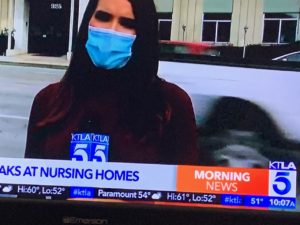
This KTLA reporter wore a facemask to cover the evacuation of a nursing home filled with elderly patients at high risk for Covid 19 virus.
While my clients are working hard to cover the Cover 19 pandemic, I’ve been revising my talent coaching lesson plans and thinking about how this worldwide health crisis will affect the future image of the on-camera journalist in TV news and online video.
A couple of trends that were already in the pipeline are likely to accelerate, while the health emergency has introduced a few new considerations. Here’s a partial list:
Social Distancing

News anchors at KTLA TV in Los Angeles practice social distancing in this two shot which has become the new normal, unless one of the co-anchors is working from home.
In normal times, I often counseled co-anchors to sit close together enough to work as a journalistic team; they should not appear to be shouting at each other from opposite ends of an oversized set. That has changed, under the social distancing imposed by the highly contagious virus. Most teams have moved farther apart. Aside from the necessity to set a good example, it just looks awkward and there’s rarely a journalistic reason for this two-shot to be there anyway. Some newsrooms have opted for one anchor in the studio, while the other works from home. Look for more stories delivered by a single talent in front of a key or an interactive screen. This means:
Less Reliance on the Prompter
This was already a trend that required news presenters to become more like weather presenters, who frequently turn away from the camera to interact with important aspects of their graphics. The job of news anchor will continue to become more like an extended in-studio live shot. Someone who is “just reading” is unlikely to satisfy audience demand for journalists who can really explain the stories they are covering. Although there are some good apps for voice-activated prompters, your home studio probably doesn’t have one anyway.

Look for news anchoring to become less about reading the teleprompter and more about explaining stories in front of interactive graphics.
News and Weather from Home Studios
OK, I’ll confess. I’m one of those viewers who loves getting a peek inside the homes of my favorite TV newscasters and online video presenters. Once your audience has seen you broadcasting from your living room, the backyard or your kids’ playroom, they’re unlikely to view you in the same way ever again. In some cases it may reinforce that certain highly paid stars are living well beyond the means of average viewers. That’s not good, when the overall message of a newscast is that we’re all in this together.
At the opposite extreme, you don’t want to put yourself up against a blank wall, in messy surroundings or backlit by a window. Choose your background wisely. Knowing the best practices for delivering news and weather from home is likely to be a job requirement in the future. Pay attention to the lighting and sound quality. Watch meteorologist Bri Eggers at KTVB in Idaho give a tour of her home studio.
Which brings us to the sensitive appearance issues. I have long maintained that the best on-camera image eliminates any distractions so that the viewer can focus on your journalism or weather expertise. While discussing appearance trends may seem trivial in these trying times, people who make their living in a visual medium have long accepted that it is just part of the job. There will be dress code guidelines specific to individual markets and even individual newsrooms, but here are a few emerging trends that are likely to be around for a while:
TV News Appearance Trends for Women
Do: Put aside the clingy dresses and miniskirts. In part because of the “MeToo” movement, they were already going away. Slimming, tailored jackets and pantsuits in solid colors are making a comeback, minus the giant shoulder pads of the 90s. This will have the added benefit of making it easier to conceal your wires and battery packs under the jacket and clipped to your waistband.
Women also need to pay attention to the trend toward “business casual” in the workplace. A soft-fitting top with a flattering neckline (not too revealing) in a solid bold color is your best option. Most people look better with at least a small sleeve. All-white is still a distraction that should be avoided, although we’re seeing more all-black these days in keeping with the seriousness of the stories we’re covering.
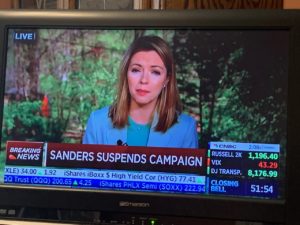
CNBC’s Kayla Tausche’s tailored jacket in a solid bold color is a great choice for this outdoor studio. Hair neatly frames her face.
Don’t: Assume that your makeup and hair routine will be the same. Makeup for high-def video can look clownish if it’s too harsh, so the trend towards a polished but more natural look will accelerate. I saw one of my favorite major-market morning anchors broadcasting from her living room with a large “statement” necklace and “pageant” makeup that looked out of place. Simple jewelry — or NO jewelry — is the trend. Your hair should be a natural and neatly styled frame for your face. People will understand if you haven’t been able to get to the stylist for a cut or color and your roots are showing. We’re all in the same boat.
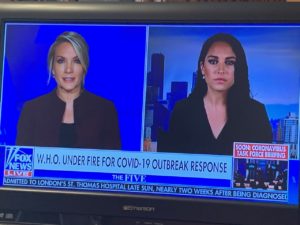
Fox News Channel’s Dana Perino has a credible and serious look in a solid color jacket and understated makeup. If long hair has become a distraction, pull it back.
TV News Appearance Trends for Men
Do: Get serious about your “business casual” game. While most TV stations still insist on business suit and tie for the studio, it’s only a matter of time before one network or station group goes more casual and sets the trend for everyone else. This means investing in shirts and knits in solid bold colors, as white is a distraction and many pastels look white. If going tieless with a jacket, make sure your shirt collar is neatly pressed so you don’t look like you slept in it.
Don’t: Neglect your personal grooming. Very few guys, except for a few movie stars, can pull off the unshaven look on TV. Hair should be neatly styled and facial hair (if allowed for on-air talent in your workplace) should be neatly trimmed.
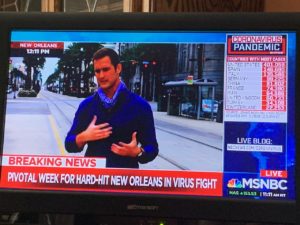
This MSNBC reporter gets the business casual look exactly right on a deserted street in New Orleans where he doesn’t need to wear a mask, but it’s visible in the shot if it’s needed.
Cleaner and Healthier Newsrooms
I spent three decades working in TV newsrooms, and every single one of them was a breeding ground for germs. We all know how quickly a common cold can spread through the entire staff. A positive outcome of the current emphasis on hygiene will be more frequent anti-bacterial wipedowns of our work stations and news sets. It has been sad to see a few of my friends who are line producers or control room personnel — and don’t have the option of working from home — battling coronavirus due to possible exposure in the workplace. Bring in wipes for your work area or the set if the station doesn’t provide them.
Observe best practices in field reporting by keeping your distance during interviews. I cringe to think of a reporter or photog having to get up close and personal to help someone clip on a mike. Sanitize your microphones to minimize spit. Carry a mask with you for the times when it’s needed during news gathering. But don’t wear it during your live shot if you are standing a safe distance away from everyone. Let’s not make an already scary situation seem even worse than it is.
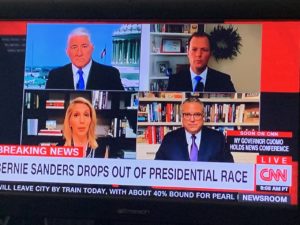
CNN talent working from home favor bookshelves as a background. Make sure they’re neatly arranged. And no, we don’t need to see your Emmy!
Voice coach Ann Utterback has long advocated a healthy lifestyle as the foundation of good talent performance. Here are her tips for maintaining a healthy voice and attitude during this crisis. Ann is also offering a free download of her Broadcast Survival Guide (normally $4.99) through May 31 with the code StressRelief.
More information about TV news and online video talent coaching is on my website. Stay healthy and hopeful that we’ll be able to work together again in the near future. And if you need a smile today, check out this PSA from Veep star Julia Louis Dreyfus about TV makeup in the time of corona virus.
"Please stay home, please stay safe, and help us flatten the curve."
Julia Louis-Dreyfus, you’ve never looked better. Let's bend the curve by staying home and keeping our distance, California. #StayHomeSaveLivescovid19.ca.gov
Posted by California Governor on Tuesday, April 7, 2020
Tweet





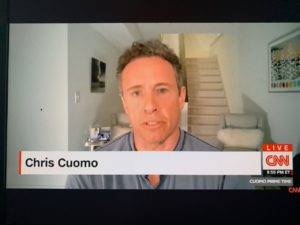
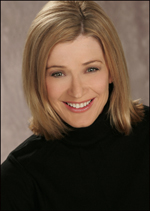 Hi, I'm Terry Anzur. I've been a professional multimedia journalist for more than 30 years, anchoring and reporting everywhere from New York to Los Angeles to West Palm Beach. I've taught on-air skills to journalists of all levels, both through positions at the University of Southern California and Pepperdine University and through my own independent company.
Hi, I'm Terry Anzur. I've been a professional multimedia journalist for more than 30 years, anchoring and reporting everywhere from New York to Los Angeles to West Palm Beach. I've taught on-air skills to journalists of all levels, both through positions at the University of Southern California and Pepperdine University and through my own independent company.